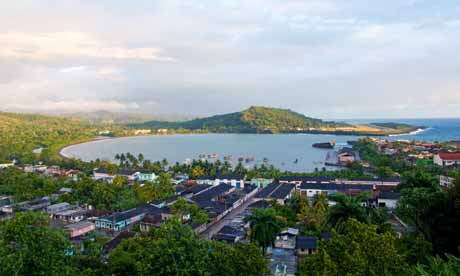
Guantánamo Bay may be notorious for its US base, but it’s also a Cuban province of cultural diversity and surprising splendour
It had never occurred to me that Guantánamo Bay might be beautiful. But it is. A sweeping horseshoe of turquoise, it’s so sheltered that it can offer a fleet protection from the fiercest of Caribbean hurricanes. At Caimanera, the nearest Cuban town to the US naval base, locals while away weekend afternoons with cans of Bucanero beer in a beach bar, while their children swim in the bay’s warm waters.
One man pointed out a tall chimney on the opposite shore. “My cousins used that chimney as a landmark when they swam over to the American base a few years ago,” he said. His cousins were intent on taking advantage of America’s policy of granting residence to any Cubans keen to defect from their Communist homeland. This group didn’t complete its escape the first night – as the sun started to rise they had to take shelter on a small island where they waited out the daylight hours. “The next night they made it, though, and once they reached shore they walked the few kilometres to the naval base. The Americans kept them there a few weeks, and then flew them to Miami. They’re still living there now.”
At Hotel Caimanera the barman lends binoculars to curious guests who can climb a few steps to a viewing point. The naval base’s lookout towers, airport, hospital and residential quarter are clearly visible. Behind, the beats of salsa and son pump out from the hotel’s poolside; toddlers squeal as they bomb down the waterslide while teenagers lounge about in long surf shorts. It’s hard to believe that within sight sits a detention camp whose alleged human rights abuses have made the name of Guantánamo Bay so loathed across the globe.
The original lease for the naval base was signed by Theodore Roosevelt in 1903. It stipulated that the US could continue to occupy the territory until both sides wished to terminate the agreement. The Cubans have insisted since the revolution of 1959 that the Americans should leave. The yanquis, however, have continued to send their annual rent cheque of $4,000, which they claim ratifies the lease despite the fact that Castro’s Cuba has each year refused to cash it.
The local Guantanameros tend to take a pragmatic view of the conflict. Many of their fathers and grandfathers moved from other parts of Cuba to Guantánamo – the island’s easternmost province, which at just over 6,000 sq km is about the size of Devon – precisely because of the naval base. The Americans offered secure jobs with good wages, and pension plans to boot.
Still today, two or three very elderly Cubans work at the base, though new jobs have not been offered to locals for many years. The Cubans are not happy that the Americans are occupying a prime chunk of their island, of course – not only do the 11 best beaches of this region fall within the bounds of the base, but US-drawn boundaries deprive the Cubans of the best shipping lanes in the bay, thereby slashing their opportunities for commerce. Yet they appear to hold no rancour towards those who have made – or continue to make – their living from the base, nor indeed towards the many who have swum across the bay to start a new life amid the shopping malls of Miami.
“Many of them find, once they get to America, that life is hard there too,” my guide, Janoxy Konstantin, explained. “I don’t want to go. I have everything I need here in Cuba.”
After a few days travelling around the province, it was much easier to understand the draw: there’s more to Guantánamo than orange jumpsuits. It’s strikingly scenic. Vivaciously lush rainforest is interrupted only by the brash purples and reds of bougainvillea and a pink spray of a flower the locals call lluvia rosa – pink rain. The Caribbean Sea laps bright turquoise on Guantánamo’s southern coast while the Atlantic meets land on the deserted, coconut-strewn beaches of the north.
Skin colour ranges from bitter-chocolate black to creamy latte: following the Haitian revolution of the late 1700s the province saw an influx of immigrants who added their genes to Cuba’s Hispano-Caribbean hotpot. Jamaican sugar- and banana-plantation workers imported their own energetic dances, alongside rice and peas – and cricket. Five members of Cuba’s national team are Guantanameros; one of them, a fast bowler, is called Stalin – his father, he told me, was a great aficionado of the Soviets.
Stalin’s not the only person with a peculiar name round here. “I have a friend whose name is Usnavi,” Janoxy said. I expressed surprise and asked how to spell it. Janoxy explained: “When her mother was pregnant, she saw a ship sailing by. On the side of the ship she saw the name: US Navy. She didn’t know what it meant, but thought it was pretty, and so she named her daughter after the ship.”